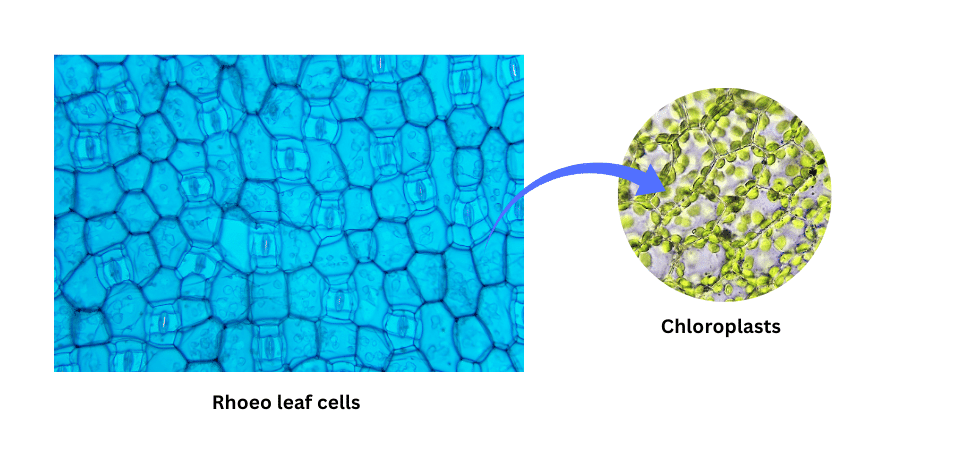6. Complete Activity 5.6 (Page 53).
• Mount the peel of a Rhoeo leaf in water on a slide and examine cells under the high power of a microscope. Note the small green granules, called chloroplasts. They contain a green substance called chlorophyll. Put a strong solution of sugar or salt on the mounted leaf on the slide. Wait for a minute and observe under a microscope. What do we see?
• Now place some Rhoeo leaves in boiling water for a few minutes. This kills the cells. Then mount one leaf on a slide and observe it under a microscope. Put a strong solution of sugar or salt on the mounted leaf on the slide. Wait for a minute and observe it again. What do we find? Did plasmolysis occur now?
Answer:
Aim: To observe peel ofRhoeo leaf under a microscope. Also, to observe what happens when you put a strong salt solution on the Rhoeo leaf as well as the boiled Rhoeo leaf and conclude based on that.
Materials Required: Rhoeo leaf, water, slide, microscope, salt solution.
Procedure:
Part 1:
(i) The peel of a Rhoeo leaf in water is mounted on a slide.
(ii) The cells are carefully observed under a microscope and the observations are noted.
(iii) A strong salt solution is put on the mounted leaf on the slide.
(iv) After a minute the leaf is observed again under the microscope.
Part 2:
(v) Next, some Rhoeo leaves are placed in boiling water for a few minutes.
(vi) Then one leaf is mounted on a slide and observed under the microscope.
(vii) A strong salt solution is put on the mounted leaf on the slide.
(viii) After a minute the leaf is observed again under the microscope.
Observations:
Part 1:
- Small green granules are seen which shown below:

- When the salt solution was put on the mounted leaf, it was observed under the microscope that there was shrinkage or contraction of the contents of the cell away from the cell wall. This phenomenon is called plasmolysis.
Part 2:
- It was observed that the contents of the cell did not shrink away from the cell wall in this case, i.e. plasmolysis did not occur.
Conclusions:
Part 1:
- The small green granules are called chloroplasts and contain a green pigment called chlorophyll, which are essential for carrying out photosynthesis.
- When the salt solution was put on the mounted leaf, the cell lost water by osmosis and hence there was contraction of the cell contents away from the cell wall.
Part 2:
- Boiling killed the cells and destroyed the plasma membrane through which osmosis takes place. Hence, there was no contraction in this case.
We can conclude that only living cells and not dead cells, are able to absorb water by osmosis.
“Mount the peel of a Rhoeo leaf in water on a slide and examine cells under the high power of a microscope. Note the small green granules, called chloroplasts. They contain a green substance called chlorophyll. Put a strong solution of sugar or salt on the mounted leaf on the slide. Wait for a minute and observe under a microscope. What do we see?
Now place some Rhoeo leaves in boiling water for a few minutes. This kills the cells. Then mount one leaf on a slide and observe it under a microscope. Put a strong solution of sugar or salt on the mounted leaf on the slide. Wait for a minute and observe it again. What do we find? Did plasmolysis occur now?” – Solved.
Related Links:
Solution to Activity 5.1
Solution to Activity 5.2
Solution to Activity 5.3
Solution to Activity 5.4
Solution to Activity 5.5
Solution to Activity 5.6
Solution to Activity 5.7
Solution to Chapter 5 The Fundamental Unit of Life


